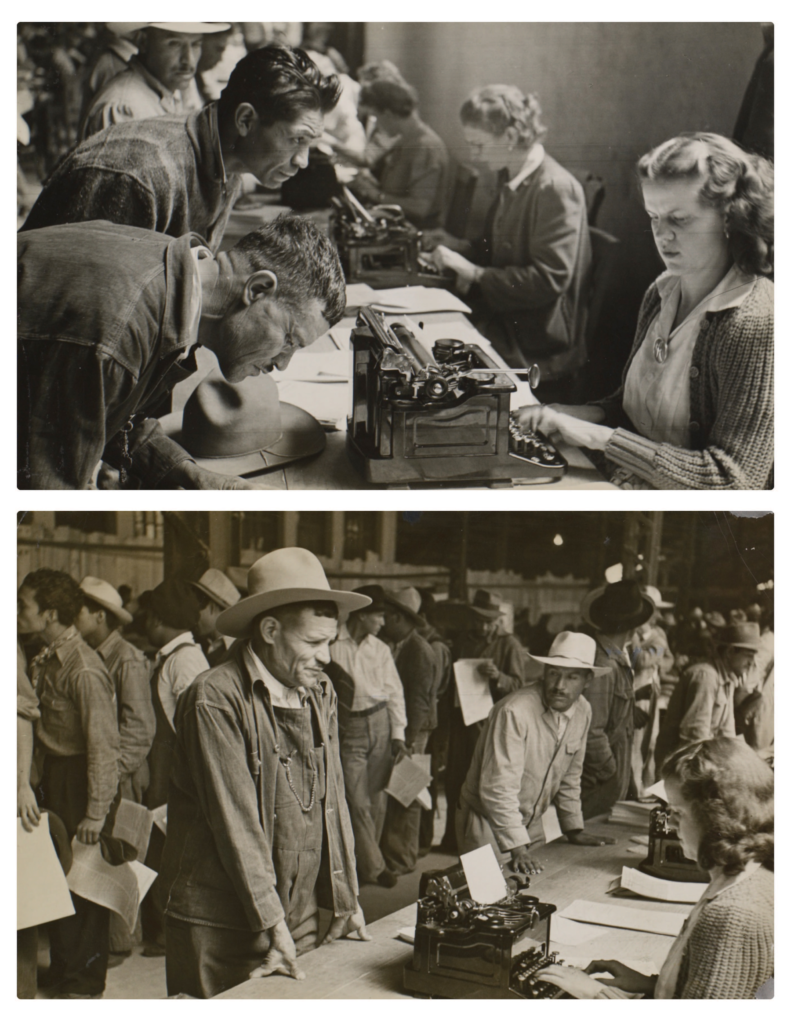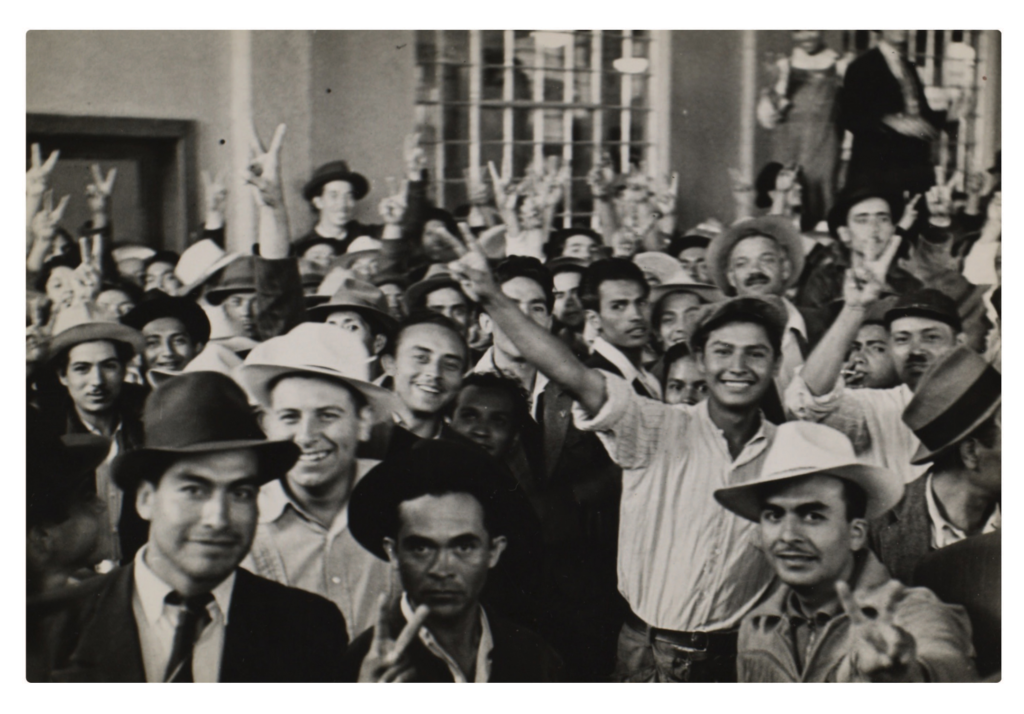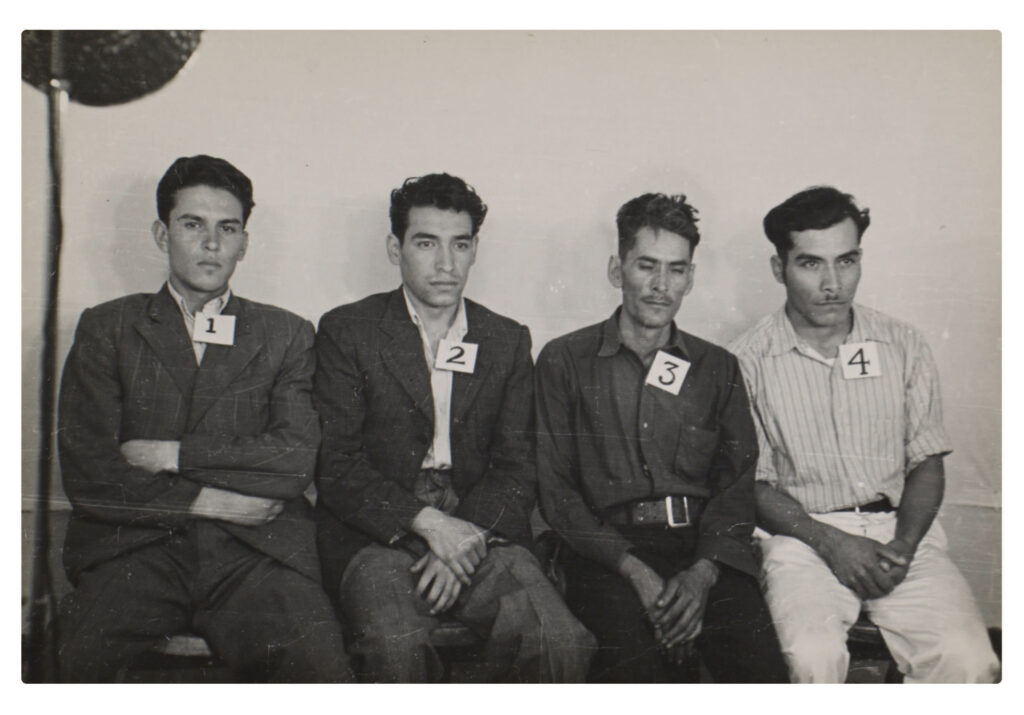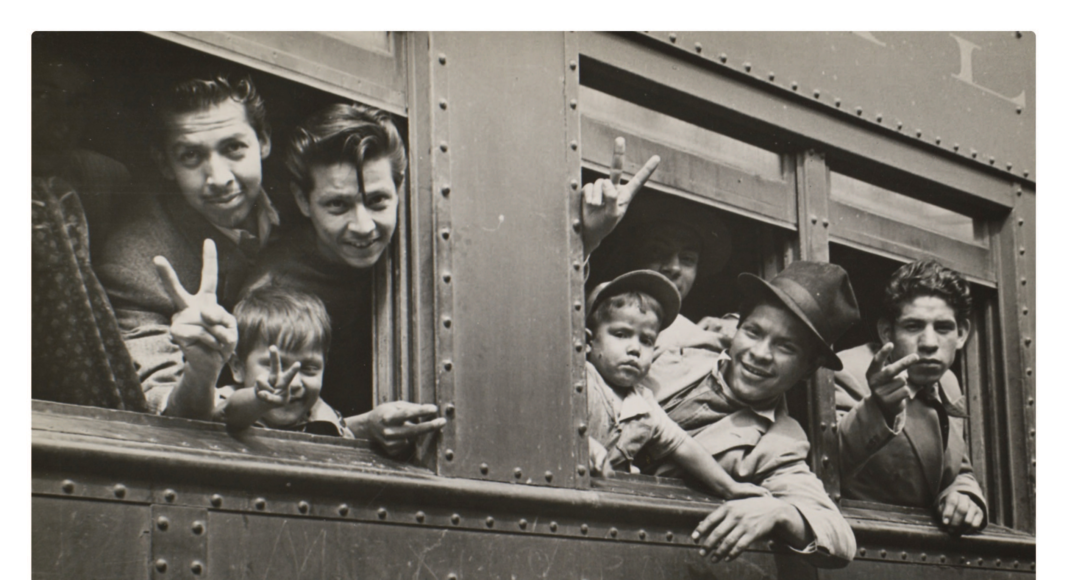Versión en español: https://www.goodtimes.sc/wp-content/uploads/sites/10/2022/09/Bracero-cover-in-spanish.en_.es_.pdf
Stanford’s Cecil H. Green Library exudes an Ivy League elegance. Art-deco pendulum chandeliers hang from vaulted ceilings, casting spotlights. Lacquered wood-paneled bookcases line the perimeter of the great room, which is so large that it never seems like anyone else is there but you. The guarded space is home to a plethora of rare documents, books and archives, which those who have permission can carefully sift through in the “special collections reading room.”
The silence is only broken when the clocktower sounds, resonating throughout the cavernous building with little impact on the few researchers, educators and archivists permitted to hunt through treasure troves of academic relics. Eight years ago, Ignacio “Nacho” Ornelas was granted that privileged access when he began working in the archives at the Stanford library. It was a perfect opportunity since he had already started documenting oral histories of braceros in the Monterey Bay region for his dissertation, “The Struggle for Social Justice in the Monterey Bay Area, 1930-2000.”
Ornelas delved deep into the archives, researching papers and documents that Ernesto Galarza had left for the university. Galarza, born in Jalcocotán, Nayarit, Mexico, in 1905, immigrated to California with his family after the Mexican Revolution. He was an activist who Ornelas calls “Cesar Chavez before Cesar Chavez.”
Ornelas stumbled upon an array of photographs and unprinted negatives scattered loosely throughout Galarza’s documents, letters and notebooks. Galarza himself didn’t take them; he had commissioned a photographer—who remains anonymous—to document the abuses in the Bracero Program, of which he was a vocal critic.
The Bracero Program was an agreement the U.S. made with Mexico that offered temporary work visas to Mexican citizens between 1942 and 1964. Galarza’s 1964 book, Merchants of Labor, documented accounts of abuses within the program, and contributed to its eventual demise.
But even before that, Galarza had advocated for years to end the program, and thought photographic evidence would help his case. Each black-and-white photograph of the Mexican workers admitted into the U.S. under the program (dubbed “braceros”) radiates an empathetic vibrancy similar to that of the blue-collar workers captured in Dorothea Lange’s work.
One image shows a line of young Mexican men signing up for the program. American women sit at desks across from them, looking down at their typewriters with intense, downward-sloping eyebrows. Another photo shows a group of shirtless men getting checked out by a doctor; Ornelas explains that most braceros came from rural parts of Mexico, and had probably never even been seen by a medical professional.

Born in the Mexican state of Jalisco and raised in Salinas, Ornelas heard a bounty of stories from his grandfather, Guadalupe Rodriguez, about his tenure as a bracero (“one who swings his arms”), and the pride he took in his work. Rodriguez became very skilled in areas that are now considered lost arts; he was a master with the cortito, a short-handled hoe used to thin lettuce, which required great strength and skill. Rodriguez’s son, German, a 62-year-old truck driver in Salinas, grew up watching his father pass on his knowledge to new braceros.
“My father always taught people the easy way to do [difficult] things,” German says. “He always said there was an easier way to do things, but sometimes you can’t see it.”
Cutting cauliflower is one example. After it’s picked, many leaves must be cut off, and Guadalupe would see many newcomers cut one leaf off at a time. He’d show them how to cut all the leaves off simultaneously.
Rodriguez passed away in 2020 at 89 years old. German and Ornelas say he had no regrets about his bracero history.
Ornelas’ reason for sharing the trove of photos is much different than Galarza’s reason for having them taken: he wants the public to experience these images the same way he experienced his grandfather’s stories. He hopes to remind those who see the images that the braceros weren’t powerless pawns who gave themselves to the U.S. government to be used, abused and discarded; the millions of Mexican men who participated in the federal program are responsible for building an agricultural empire on the Central Coast and beyond. The photos convey the humanity of a group of workers who are more often considered as statistics.
“These beautiful photographs need to be in public view,” Ornelas says.
Broken Promises
The Bracero Program was the most extensive guest worker program in U.S. history. More than two million Mexican men came to the country on short-term labor contracts between 1942 and 1964—an estimated 4.6 million contracts were signed. In exchange for the work, employers paid “market wages” and provided “sanitary conditions, free housing, affordable meals, occupational insurance and free transportation back to Mexico.” Or so they claimed.
During President Franklin D. Roosevelt’s administration, which instituted the earliest version of the Bracero Program, many fieldworkers endured horrendous conditions. Few promises were kept, so when a U.S. labor shortage instigated a second incarnation of the program during World War II, the Mexican government insisted the braceros receive adequate food, shelter and transportation.
By 1947, Bracero Program 2.0 was shut down. As a result, undocumented immigration into the U.S. skyrocketed throughout the 1950s, so the U.S. government came to yet another agreement with Mexico in 1952, reinstating the program to curb the stream of immigrants without papers; they would give sanctioned avenues into the U.S. to Mexican men looking to work. However, the agreement included some seemingly confusing stipulations, such as the fact that braceros weren’t allowed to strike, but they also weren’t allowed to work as scabs when other workers were striking.
Ornelas says that when the braceros first came to the Salinas Valley in 1942, Monterey County’s total ag production was about $17 million. When the program was axed in 1964, it had skyrocketed to $152.7 million.
Teaching the Legacy
Before Ornelas went to grad school, he worked as a U.S. History teacher at Alisal and Everett Alvarez High Schools in Salinas. That’s when he first began thinking about braceros and how outdated curriculums and ways of thinking have indirectly made students feel ashamed of their history.
“When I was a teacher, I found many kids were embarrassed about their heritage,” Ornelas says.
About two million young men entered into the bracero labor agreement for a chance to achieve the “American dream.” Many would return to Mexico or make multiple migrations back and forth. “Migration and immigration have continued,” Ornelas says. “You’re talking about a population dealing with families starving in rural Mexico; some came from urban areas. Some came from working-class backgrounds. So, the stories are not all the same. Some people endured a lot of abuse, returned to Mexico and never returned to the U.S.”
The braceros’ labor was responsible for creating and saving a struggling agricultural industry. Some of the ag entrepreneurs of the 1940s and ’50s were struggling because of the war, but the program turned a million-dollar sector into a $40 million industry in Monterey County alone. Within 22 years, it became a $200 million industry. Now it’s a multibillion-dollar industry in Monterey County with crops like strawberries, lettuce, cauliflower and broccoli.

“Part of [what I want to do] is to get the stories out in the cross-cultural and international education space,” says Ornelas. “We’ve developed a lesson plan readily available to any teacher.”
That lesson plan, “Mexicans in the US Agricultural Workforce,” has been approved to be used as part of schoolwide curriculums. Ornelas hopes teachers and school administrators will be open to this untold story. Not just the heartbreak and the abuses but allowing students to have pride in who they are and whatever their parents do for a living.
“Educate teachers and tell them that when you drive down these fields, it’s not just about feeling pity for these farmers,” Ornelas says. “These farmworkers are making significant contributions to the local agricultural economy and the nation. These are essential workers. I’m talking about that 8-year-old attending elementary school in Watsonville whose parents work hard. They appreciate how hard their parents work, but feel ashamed when they get to the classroom. I saw it so many times.”
Historically, educators have looked down upon working-class jobs.
“We have a lot to learn from the working-class population of this country, including farmworkers and agricultural workers; these are human beings, dignified people who are very intelligent,” Ornelas says. “Few know how to decide which piece of lettuce to consistently cut, trim and pack all day. It’s also about empowering young people to say their parents might be doing this challenging, backbreaking work. It’s something that we should all be proud of. They are making significant contributions.”
Art Meets History
Tijuana artist Daniel Ruanova embraced the identity he had long tried to reject—a border artist, or in his words, a “border rat”—after spending three years in an art district outside of Beijing with his wife.
In 2013, a restaurateur and childhood friend commissioned Ruanova to create a centerpiece for his new high-end restaurant in San Diego, Bracero Cocina. Ruanova discovered a new sense of creative direction when studying the braceros’ history. The gig opened a new door of perception; he wanted to explore the history of the men who participated in the program that has been scorned for decades.
Ruanova created a mechanical sculpture, “The Mexican Labor Agreement,” which features 32 cortitos for the restaurant. The cortitos represent one of the standard tools of the bracero trade. The number “32” is a tribute to the 32 braceros tragically killed in 1963 when the bus transporting them from their Chualar labor camp to Salinas Valley celery fields collided with an oncoming train.
Creating the sculpture for the restaurant wasn’t enough for the artist. He wanted to delve deeper into the history of braceros.
“I started to reach out to all of the academics who were looking for a different narrative than the politically-correct narrative that is now the Mexican-American history in the United States,” Ruanova explains. “[Ornelas] was the only person who got back to me.”
Ornelas invited Ruanova to Salinas to talk to braceros himself and feel the soil in his hands.
“Daniel gets it, and through his art, he wants to honor the braceros,” Ornelas says.
With sponsorship from Stanford University, Ornelas and Ruanova launched the Bracero Legacy Project in 2015 to bring that paradigm shift of the braceros to the public using art, history and education. The duo asserts that the braceros weren’t meek people “willing to embondage themselves.”
Everything that the Bracero Legacy Project does is part of an effort to reframe how braceros are understood in U.S. history, “with much more attention paid to the sense of hope and opportunity the program inspired in its participants.”

Ornelas knew the photos he had found were more significant than his dissertation, which is where Ruanova’s perspective as a visual artist comes in.
“He encouraged me to get this beautiful history and artwork out to a larger audience,” Ornelas says. “It’s meant for the public to see.”
Adds Ruanova, “We’re doing public intervention with the [Galarza] archival photography. The photographers were sent out to vilify the braceros. In the end, there were many positive experiences for the braceros.”
Ornelas aims to open discussions that academics have mostly avoided throughout the years.
“There was a period where historians were good about documenting the abuses and the history and all that,” he begins. “But I found it difficult to make a connection to [braceros’] legacy. Who are their kids? Where are their grandkids? I started to find remarkable stories of people who are now city council members, state senators, members of Congress and entrepreneurs who had parents or grandparents who were former braceros.”
Ornelas has spent a lot of time documenting these individuals, like Monterey County Supervisor Simon Salinas and former Watsonville Mayor Ana Ventura Phares—whose father was a bracero.
“We’re familiar with the overt abuse that occurred,” he says. “But part of the Bracero Legacy Project highlights all the various journeys.”
Before the Bracero Program began, intergenerational families from impoverished Mexican countryside communities had already been betrayed by the Mexican Revolution, which was supposed to provide agrarian reform and land-owning opportunities to peasants, but never brought upward economic mobility.
Ruanova and Ornelas don’t discount any of the hardships of migration, immigration and everything that comes with it. It continues in 2022.
“The ugly, the bad separation, the different forms of working-class poverty in places like Watsonville and Salinas,” Ornelas says. “There are many broken bodies; agricultural labor [takes a toll] on the body—and the toxins and pesticides on top of everything.”
‘Transborder’ Comes to MAH
On Sunday, Sept.18, Ornelas and Ruanova will bring the BLP to Santa Cruz, starting with a discussion that will feature acclaimed photojournalist David Bacon, who’s been documenting agricultural laborers for about four decades. The conversation will focus on the history of ag workers and the Bracero Program, but they will also discuss modern-day braceros, like the H-2A workers.
“Many people think that the Bracero Program officially ended in 1964, but the U.S. is continuing to recruit and bring agricultural workers, mostly from Mexico, to work in places like Watsonville, Monterey County and across California,” Ornelas explains.
The Legacy Project’s most crucial component is bringing the history, the stories and the education to the public. While museums are essential outlets to showcase the work, Ruanova and Ornelas want more people to be exposed.
As part of CommonGround, the Santa Cruz Museum of Art & History’s new “biennial festival of place-inspired, outdoor work hosted in locations throughout Santa Cruz County,” Ruanova and Ornelas have created “Transborder.”
The mobile installation features an assortment of Galarza’s mesmerizing photos, enlarged and attached to wood sculptures constructed by Ruanova. Each image will include an audio component featuring the oral histories Ornelas has collected and music from the era, including a rare recording of a song, “Tragedy at Chualar,” about the accident that killed 32 people.
The “train” of photos on wheels will be on display at three Santa Cruz farmers markets: Downtown Santa Cruz (Sept. 21, 1-6pm), Watsonville (Sept. 23, 2-7pm) and Live Oak (Sept. 25; 9am-1pm).
“We want to give new light to the images of citizens on their journey to the land of opportunity,” Ornelas says.
The Santa Cruz Museum of Art & History will present ‘Transborder Braceros, Labor History, and Art,’ a conversation featuring Ignacio Ornelas, Daniel Ruanova and David Bacon, on Sunday, Sept. 18, 2pm., at the MAH, 705 Front St., Santa Cruz. Free with registration. santacruzmah.org.














Could you translate this into Spanish for farmers and farmworkers across the Monterey Bay Region?